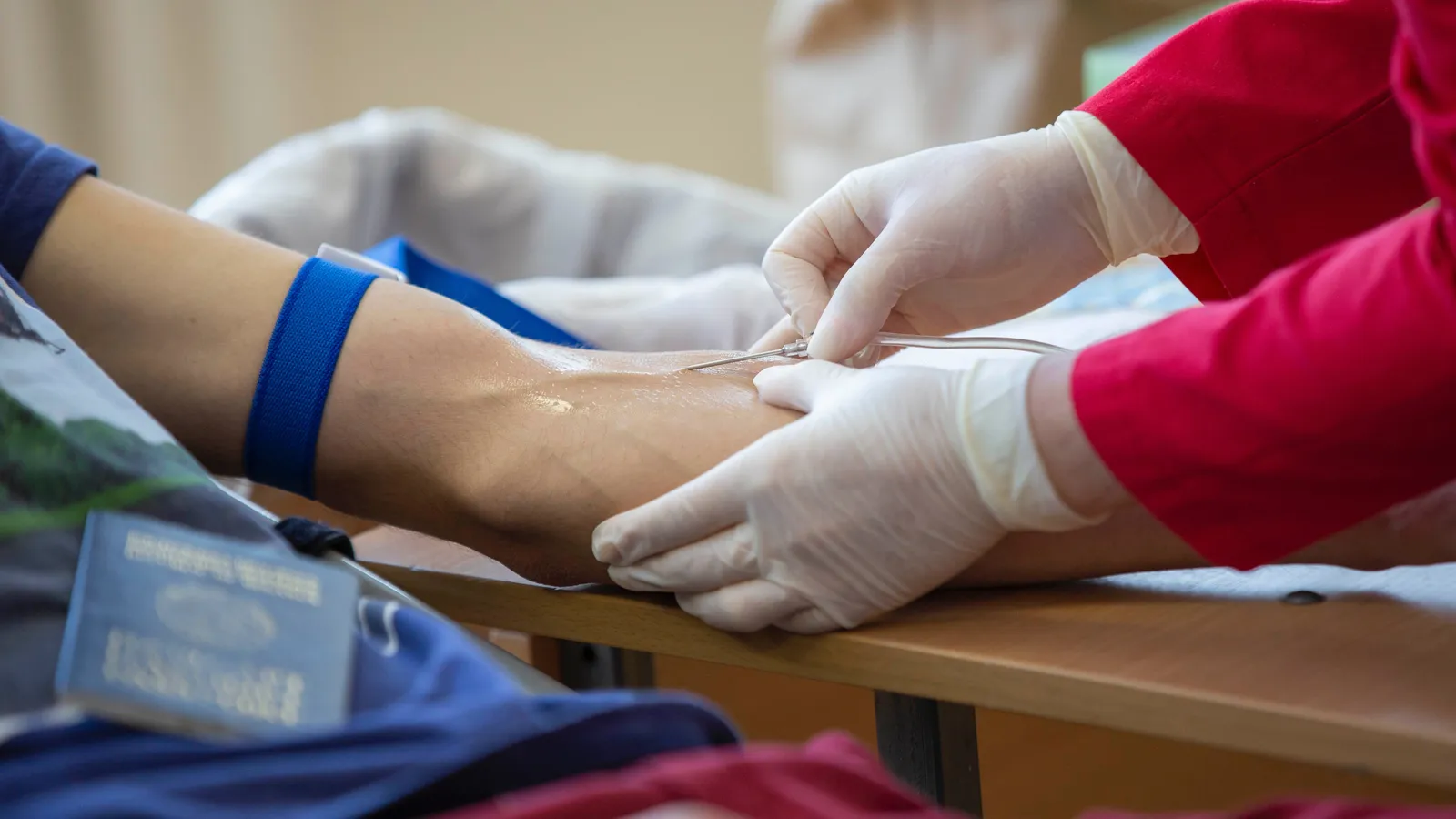New Donor?
Thank you for your interest in becoming an Olgam Life donor! You are welcome to stop by at any time, no appointment necessary.
Just be sure to bring:
1. Your current, unexpired ID
2. Proof of address within 50 miles of a center (a piece of mail or a bill with your full name and address will do)
3. Your social security card or a tax document with your full name and SSN displayed
The center will help you complete a health questionnaire and conduct a quick physical to determine your eligibility. After each successful donation, you will be paid between $50-$60 in NYC and between $50-$140 in Florida.
We hope to see you soon!
The Science behind Plasma Donation

The Science behind Plasma Donation
Plasma, the clear fluid component of blood, provides a critical lifeline for many patients via its role in clotting, nutrition, and immunity. This article clearly explains the science behind plasma donation, what plasma is, how donated plasma sustains modern medicine, and the fascinating technology behind plasma collection. Readers can gain valuable insights into this vital bodily fluid and the immense, yet often unrecognized, impact of plasma donors in saving lives through their compassionate donations.
Plasma is the clear fluid part of blood, making up 55% of total blood volume. It contains water, proteins, nutrients and waste products. Plasma serves vital functions like clotting blood, defending against infections, and transporting hormones and molecules. Donated plasma provides material to manufacture therapies for trauma, immune disorders, and bleeding diseases.
Understanding Plasma and Its Role in the Human Body:
Title | Details |
What is Plasma? | A clear, straw-colored liquid, constituting about 55% of blood. Composed of 92% water, proteins, nutrients, hormones, gases, and waste products. |
Key Plasma Proteins | Albumin (transports molecules), Clotting factors (blood clot formation), Immunoglobulins (fight infection). |
Functions of Plasma | Transporting blood cells and nutrients, facilitating respiration, nutrition, excretion, regulation, and immunity. |
Plasma in Medicine | Used in emergency treatments, genetic deficiency therapies, autoimmune disorders, and passive immunization (e.g., COVID-19). |
Impact of Plasma Donation | Vital for manufacturing plasma protein therapies, supporting patients with chronic conditions, trauma victims, and biomedical research. |
What is Plasma?
Understanding Blood Plasma and Its Components
Blood plasma is a clear, straw-colored liquid that makes up about 55% of total blood volume. It is comprised mostly of water (92% by volume) along with proteins, nutrients, hormones, gases, and waste products. The unique composition of plasma allows it to serve vital functions within the circulatory system.
Plasma contains over 700 different proteins that perform various roles, including blood clotting, immune defense, and molecule transport. Some key plasma proteins include:
Albumin - transports hormones, fatty acids, and other molecules
Clotting factors - enable blood clot formation
Immunoglobulins - antibodies that fight infection
In addition to proteins, plasma carries glucose, fats, amino acids, and other nutrients needed for cellular metabolism. Oxygen, carbon dioxide, and waste products are also exchanged via plasma throughout the body. This diverse mix of components equips plasma to support homeostasis across systems.
The Role of Plasma in the Human Body
As the liquid component of blood, plasma serves as the medium for transporting blood cells and nutrients to tissues while also ferrying waste products away. This circulation facilitates a range of essential bodily processes:
Respiration - Plasma transports oxygen from the lungs to tissues and carbon dioxide in the opposite direction.
Nutrition - Glucose, amino acids, vitamins, minerals, and other biomolecules travel dissolved in plasma to nourish cells.
Excretion - Metabolic waste products like urea are filtered out in the kidneys and released from the blood via plasma.
Regulation - Hormones secreted by endocrine glands reach target organs through plasma circulation. This helps coordinate biological processes.
Immunity - Plasma conveys antibodies, complement proteins, and immune cells to sites of infection for pathogen neutralization and removal.
In essence, plasma provides a flexible matrix for the circulation and delivery of myriad substances throughout the body. This elegant transportation system crucially links nutritional supply, gas exchange, metabolic activity, waste removal, and defense mechanisms across cell networks - enabling integrated functioning and homeostasis.

How is Plasma Used in Medicine?
Plasma in Medical Treatments and Therapies
Plasma serves a vital role across a spectrum of medical applications - from treating traumatic injuries to managing chronic illnesses. Its unique composition equips it to transport life-sustaining proteins, clotting factors, and antibodies into patient circulation.
In emergency rooms, plasma is administered to replace blood volume after serious accidents involving severe blood loss. Containing clotting factors like fibrinogen, infused plasma enables rapid blood clot formation to stem bleeding. Plasma also helps resuscitate organ function by restoring circulating albumin and nutrient transport.
Specific plasma therapies can also treat genetic deficiencies that disrupt clotting or immune function. For hemophilia patients lacking key clotting factors, plasma introduces the missing proteins to prevent excessive internal bleeding episodes.
For those battling autoimmune disorders, introducing immune globulins via plasma provides reinforcement against self-targeting antibodies. Olgam Life plasma donors making regular donations are helping provide the raw materials for creating these lifesaving protein-based drugs.
Beyond protein replacement, the antibody-rich fluid component of plasma plays a key role in passive immunization therapies. Transfusions of convalescent plasma, harvested from prior virus survivors, equip patients with neutralizing antibodies to combat active infections like COVID-19 or influenza.
The Impact of Plasma Donation on Healthcare
So, let’s talk about navigating the world of plasma donation. Plasma obtained from regular, voluntary whole blood donations represents an absolutely vital healthcare resource. Donated plasma provides the starting material for manufacturing plasma protein therapies administered to hundreds of thousands of patients each year.
Patients battling chronic conditions like primary immunodeficiency disorders often require weekly infusions of plasma-derived immune globulin over their entire lifetime to shore up their body’s defenses. Similarly, hemophilia patients need recurrent clotting factor replacement to carry out normal activities without risking dangerous internal bleeding.
For trauma and burn victims rushed into emergency rooms, transfusions of donated plasma serve as a critical bridge helping to replace fluid volume while supporting clot formation and organ function. In the aftermath of mass casualty events, local plasma reserves must be adequate for responding to surges in demand.
Beyond patient treatment applications, donated plasma also fuels biomedical research initiatives - enabling scientific investigation into disease mechanisms and treatment modalities. The proteins, metabolites, hormones, and antibodies within healthy plasma provide scientists with a window into normal human physiology. Comparing disease-state plasma then allows researchers to pinpoint aberrations that drive pathology.
As a result, plasma donation not only helps save existing lives but also paves the way for developing next-generation therapies that will save countless more lives. Keeping donation-based plasma supplies steadfastly flowing ensures that patient needs can continually be met while powering breakthrough discoveries.

The Process of Plasma Donation
Eligibility and Preparation for Donating Plasma
Donating plasma makes such a difference in the world and plasma is an unrecognized hero in healthcare. Donating plasma is generally very safe, but most centers do establish eligibility criteria to ensure donor health and maintain plasma quality standards. Before their first donation, potential donors complete a medical history questionnaire and mini-physical. Factors assessed include:
Age - Most centers accept donors ages 18-65 who are in good health.
Weight - Meeting the minimum weight threshold helps avoid reactions.
Medical History - Certain conditions like bleeding disorders or some cancers may disqualify candidates.
Lifestyle - Intravenous drug use, recent tattoos/piercings, or high-risk sexual behaviors require deferral periods before donating.
Meeting basic eligibility opens up a vital opportunity to help save lives. Suitable donors should eat a healthy meal and drink extra fluids before arriving to donate. This helps boost plasma volume available for collection. At an Olgam Life plasma collection center, staff provide reminders about ideal pre-donation preparation.
Step-by-Step Guide to the Plasma Donation Process
Donating plasma is simple, safe, and convenient when visiting one of Olgam Life's modern community-based branches. Here is what donors can expect:
Check-In - Donors scan their unique donor ID card at reception and answer basic health screening questions each visit.
Vital Signs - Staff record weight, blood pressure, pulse, and temperature to ensure donors are healthy enough to donate that day.
Phlebotomy Site Cleansing - The venipuncture site on the donor's arm gets wiped down with an antiseptic solution.
Plasma Collection Initiation - Using sterile technique, a trained phlebotomist inserts a needle with attached tubing into the donor's arm vein to establish access.
Automated Plasma Separation - Blood flows from the needle into an automated machine that spins and separates out the straw-colored plasma, collecting it into a bottle. Red cells get returned to the donor.
Monitoring - Staff keep close watch checking vitals and monitoring donors, who can relax in a massage chair during the roughly 45-minute collection.
Saline Return - Once the targeted plasma volume gets collected, sterile saline flows back into the donor's arm, replacing some lost fluid.
Post-Donation Refreshments - Donors enjoy snacks and drinks at the refreshment bar before leaving with compensation funds loaded onto their prepaid card.
The ability to multi-task - reading, working online, watching TV - during an Olgam Life plasma donation makes the process fast and convenient. And donors have the profound satisfaction of knowing they are helping transform lives through their compassionate gift.
Plasma Donation Process and Technology:
Title | Details |
Eligibility for Donation | Donors aged 18-65, meeting weight and health criteria, with no disqualifying medical history or lifestyle factors. |
Plasma Donation Steps | Check-in, vital signs check, phlebotomy site cleansing, plasma collection, monitoring, saline return, and post-donation refreshments. |
Plasmapheresis Technology | Automated process separating plasma from blood using centrifugal force. Maximizes plasma supply while preserving donor health. |
Innovations in Donation Tech | Automated systems for efficiency and safety, real-time vital sign monitoring, and continuous quality analysis for optimal plasma collection. |
Frequency of Donation | Allows more frequent donations compared to whole blood, with plasma volume regeneration within 24-48 hours. |

The Technology Behind Plasma Donation
Understanding Plasmapheresis and Its Mechanism
The automated process of plasma collection, known as plasmapheresis, utilizes specialized equipment to safely and efficiently separate out plasma from whole blood components. This technology, as employed at Olgam Life plasma centers, involves creating a temporary intravenous circuit to divert blood flow through an integrated centrifuge-based cell separator.
This automated device spins the blood routed from the donor to leverage fractional separation via centrifugal force. The lower density plasma fluid separates out towards the periphery while the denser cellular fraction (red and white blood cells, platelets) settles closer to the rotor axis. The system then collects only the straw-colored plasma, which flows into an accumulation bottle while simultaneously returning the concentrated cellular components back to the donor.
This counterflow process allows donors to donate plasma much more frequently than they could safely provide whole blood donations. Reinfusing the donor's own cells preserves counts while the body regenerates the removed plasma volume within 24-48 hours. The plasmapheresis approach thus creates a win-win - maximizing plasma supply for medical use while enabling donors to give life-saving plasma on an ongoing basis.
Innovations and Advancements in Plasma Donation Technology
Early plasmapheresis systems required manual plasma extraction steps by technicians. However, newer fully automated technologies employed at modern centers like Olgam Life’s have led to major gains in collection efficiency, consistency, sterility, and safety while also improving overall donor comfort.
Sophisticated optical sensors gauge plasma concentrations on the fly, enabling the separators to self-regulate pumping speeds for precisely targeted volumes tailored to each donor's profile. This customization helps avoid under- or over-collection. The newest centrifuges and pumps have further minimized vibration and noise for increased comfort.
State-of-the art collection monitoring systems also track vital signs in real-time and can pause/stop collection should any parameter fall outside personalized normal bounds for a donor. Advanced software additionally enables detailed collection data review - supporting continuous quality analysis and calibration toward optimal standardization.
Looking ahead, emerging technologies like advanced automation, robotic assistance, virtual/augmented system interfaces, and health analytics point toward continued progress in consistency, customization, access, and the overall donation experience. Olgam Life prides itself on investing in the most advanced equipment to provide the utmost in plasma collection safety and efficiency while fostering community trust and comfort. For more information, explore our FAQs on plasma donation or reach out to our team for personalized assistance in making the decision to donate or find a nearby plasma center.
















